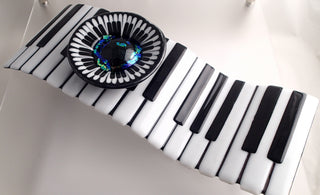The Process of Fusing
Glass is a versatile material that can be made into a variety of items for different purposes, from decorative use to industrial applications. Layers of glass are melted together becoming...

Nov 15 – Dec 31
Your Art Deserves the Best — Celebrate Colour Your Way.
Glass is a versatile material that can be made into a variety of items for different purposes, from decorative use to industrial applications. Layers of glass are melted together becoming...

Glass is a versatile material that can be made into a variety of items for different purposes, from decorative use to industrial applications. Layers of glass are melted together becoming one piece, using a kiln. Based on size and thickness a specific firing schedule is prepared and programmed into the kiln at temperatures ranging between 1200-1700 deg F.
This is actually one of the oldest methods of working with glass, as some historians say it goes back to the time of the Ancient Egyptians. However, the first definitive evidence of glass fusing can be traced back to the Romans, who used this technique before the discovery of glass blowing.
Many techniques can be used to alter the glass and can last anywhere from 6 to 24 hours in one firing schedule. Many times pieces are fired, two three or even four times, carefully controlling the process through varying the temperature in the kiln resulting in getting the desired effect.

Glass that is used for fusing is different from the panes of glass in your windows (called Float glass) or wine bottles (although that could be used / recycled). Different types of glass expand and contract at various temperatures. The various temperature change is known as the COE or the Coefficient of Expansion. If you don’t use all the same COE, the stress could cause it to crack or break. It comes in large and small sheets, powder, stringers, and all colours to choose from based on your project.
2. Designing your piece

The process itself is simple, but can be extremely time consuming. Like a puzzle each piece of a design is carefully cut and laid out prior to `fusing`. Designs can be dimensional or flat, functional or decorative. A project generally begins with a base layer (often one or two pre-cut glass Bases) with a design layer on top, including glass accents, and focal elements.
3. Fusing your piece

The basic idea behind fused glass is that art objects can be created by melting glass in a kiln. That simple idea is behind hundreds of techniques. Once all the glass sections are assembled, the piece must be transferred to the kiln to fuse the individual components into a single piece of glass. The kiln is then slowly taken from room temperature up to 1000-1700 degrees Fahrenheit. Different effects can be created by combining the variables of time and temperature. It is carefully heated and cooled to ensure the durability and quality. This process takes anywhere from five hours to several days, depending on the volume of glass being fired.
Your cart is currently empty.
Start Shopping